Scottish household survey 2019: culture and heritage - report
Reports on culture and heritage data from the 2019 Scottish Household Survey.
This document is part of a collection
4 Participation in Cultural Activities
2019 data show that 75 per cent of adults in Scotland participated in a cultural activity (Table 4.1). Reading was the most common cultural activity (see below). When reading is excluded, participation was 52 per cent. Both participation figures have been maintained since 2018.
Note that although the figures for years 2012 to 2017 are given in Table 4.1 in order to provide broader context for the trend data, these should not be used for drawing comparisons between pre-2018 data and data from 2018 onwards due to the changes made to the wording of the cultural participation questions.
| Adults | 2012 | 2013 | 2014 | 2015 | 2016 | 2017 | * | 2018 | 2019 |
|---|---|---|---|---|---|---|---|---|---|
| Participation (exc. reading) | 48 | 49 | 50 | 52 | 53 | 54 | * | 53 | 52 |
| Participation (inc. reading) | 78 | 78 | 79 | 79 | 79 | 78 | * | 76 | 75 |
| Base | 9,890 | 9,920 | 9,800 | 9,410 | 9,640 | 9,810 | * | 9,700 | 9,780 |
* Due to the changes made to the cultural participation questions in 2018, the previous years are not directly comparable.
Figure 4.1 shows levels of participation by adults in specific cultural activities in the last 12 months for 2019 data. Reading a book for pleasure was by far the most common cultural activity, with 62 per cent of respondents saying that they had done this in the last 12 months.
The next most popular activity was viewing performances online (23 per cent), followed by crafts (16 per cent). Participation levels in all other cultural activities were 12 per cent or less.
One in four people (25 per cent) had not participated in any cultural activity in the last 12 months.
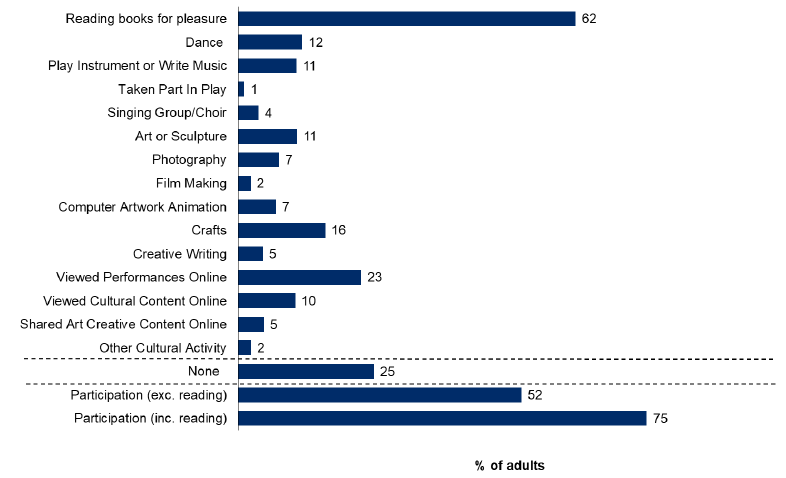
4.1 Participation by Gender
2019 data show, similarly to attendance patterns, that more women than men reported having participated in a cultural activity in the last 12 months. Eighty per cent of women had participated in a cultural activity in the last 12 months compared with 70 per cent of men, though this varied by activity (Figure 4.2). When reading is excluded, the difference between women and men was smaller (six percentage points).
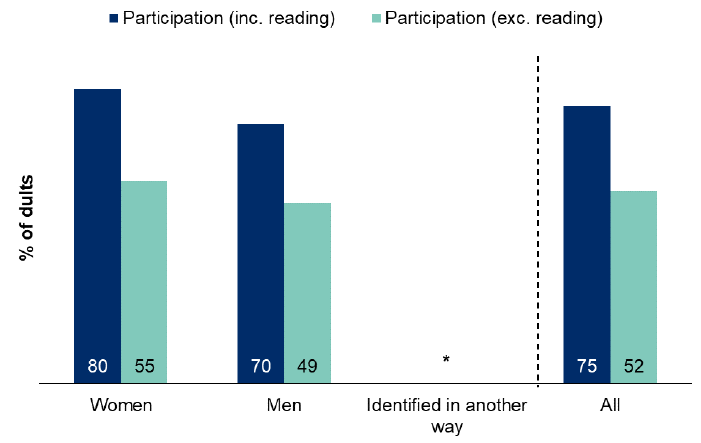
Table 4.2 shows more women than men participated in a number of cultural activities including crafts (24 per cent compared with eight per cent), reading books for pleasure (70 per cent compared with 54 per cent) and dance (17 per cent compared with six per cent).
Men had higher participation rates than women, however, in other cultural activities – including playing a musical instrument or writing music (14 per cent of men and eight per cent of women) and viewing performances online (25 per cent of men and 21 per cent of women).
| Adults | Women | Men | Identified in another way | Refused | All |
|---|---|---|---|---|---|
| Reading books for pleasure | 70 | 54 | * | * | 62 |
| Dance | 17 | 6 | * | * | 12 |
| Play Instrument or Write Music | 8 | 14 | * | * | 11 |
| Taken Part In Play | 1 | 1 | * | * | 1 |
| Singing Group/Choir | 5 | 2 | * | * | 4 |
| Art or Sculpture | 13 | 9 | * | * | 11 |
| Photography | 6 | 9 | * | * | 7 |
| Film Making | 2 | 3 | * | * | 2 |
| Computer Artwork Animation | 6 | 8 | * | * | 7 |
| Crafts | 24 | 8 | * | * | 16 |
| Creative Writing | 5 | 4 | * | * | 5 |
| Viewed Performances Online | 21 | 25 | * | * | 23 |
| Viewed Cultural Content Online | 10 | 11 | * | * | 10 |
| Shared Art Creative Content Online | 4 | 5 | * | * | 5 |
| Other Cultural Activity | 2 | 3 | * | * | 2 |
| None | 20 | 30 | * | * | 25 |
| Participation (exc. reading) | 55 | 49 | * | * | 52 |
| Participation (inc. reading) | 80 | 70 | * | * | 75 |
| Base | 5,410 | 4,360 | 0 | 0 | 9,780 |
Columns add to more than 100 per cent since multiple responses allowed.
4.2 Participation by Age
Overall, and in contrast to attendance patterns, 2019 data show that cultural participation was broadly similar for all age groups. Participation decreased with age, however, when reading was excluded from the measure, reflecting the high level of reading amongst older age groups. Sixty per cent of 16 to 24 year olds had participated in cultural activities when reading was excluded compared to 33 per cent of those aged 75 and over (Figure 4.3).
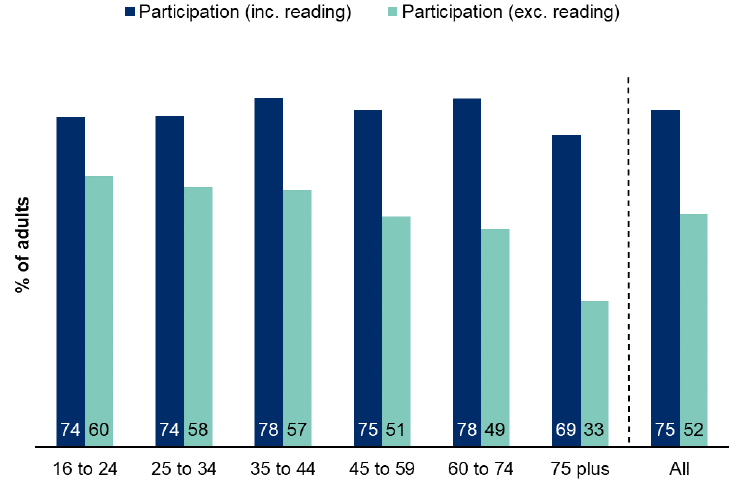
For most individual cultural activities, younger adults, particularly those aged 16 to 24, were more likely than older age groups to participate (Table 4.3). The biggest difference can be seen for viewing performances online (34 per cent of 16 to 24 year olds and four per cent of those aged 75 and over).
Compared to the 16 to 24 age group, those aged 75 and over were, however, more likely to read books for pleasure (63 per cent compared to 51 per cent) and to do craftwork such as knitting, woodwork and pottery (18 per cent compared to eight per cent).
| Adults | 16 to 24 | 25 to 34 | 35 to 44 | 45 to 59 | 60 to 74 | 75 plus | All |
|---|---|---|---|---|---|---|---|
| Reading books for pleasure | 51 | 57 | 63 | 64 | 69 | 63 | 62 |
| Dance | 12 | 14 | 14 | 12 | 10 | 5 | 12 |
| Play Instrument or Write Music | 18 | 15 | 12 | 10 | 7 | 3 | 11 |
| Taken Part In Play | 3 | 1 | 1 | 1 | 1 | 0 | 1 |
| Singing Group/Choir | 6 | 3 | 3 | 4 | 4 | 3 | 4 |
| Art or Sculpture | 17 | 16 | 13 | 9 | 7 | 3 | 11 |
| Photography | 10 | 10 | 10 | 7 | 6 | 3 | 7 |
| Film Making | 5 | 4 | 3 | 2 | 1 | 0 | 2 |
| Computer Artwork Animation | 11 | 10 | 9 | 7 | 4 | 2 | 7 |
| Crafts | 8 | 13 | 17 | 16 | 21 | 18 | 16 |
| Creative Writing | 11 | 6 | 3 | 3 | 3 | 2 | 5 |
| Viewed Performances Online | 34 | 32 | 27 | 22 | 15 | 4 | 23 |
| Viewed Cultural Content Online | 11 | 13 | 12 | 11 | 10 | 3 | 10 |
| Shared Art Creative Content Online | 8 | 7 | 6 | 4 | 3 | 1 | 5 |
| Other Cultural Activity | 2 | 2 | 3 | 2 | 3 | 2 | 2 |
| None | 26 | 26 | 22 | 25 | 22 | 31 | 25 |
| Participation (exc. reading) | 60 | 58 | 57 | 51 | 49 | 33 | 52 |
| Participation (inc. reading) | 74 | 74 | 78 | 75 | 78 | 69 | 75 |
| Base | 620 | 1,320 | 1,420 | 2,410 | 2,540 | 1,470 | 9,780 |
Columns add to more than 100 per cent since multiple responses allowed.
4.3 Participation by Highest Level of Qualification
Similarly to cultural attendance, 2019 data show that participation in cultural activities was highest among adults with a degree or professional qualification (91 per cent) and lowest for those with no qualifications (54 per cent) (Figure 4.4). In general, and similarly to cultural attendance patterns, there was a decrease in participation with level of qualifications. When reading is excluded, the difference in participation between the two groups was even greater (69 per cent for those with a degree or professional qualifications compared with 28 per cent for those with no qualifications).
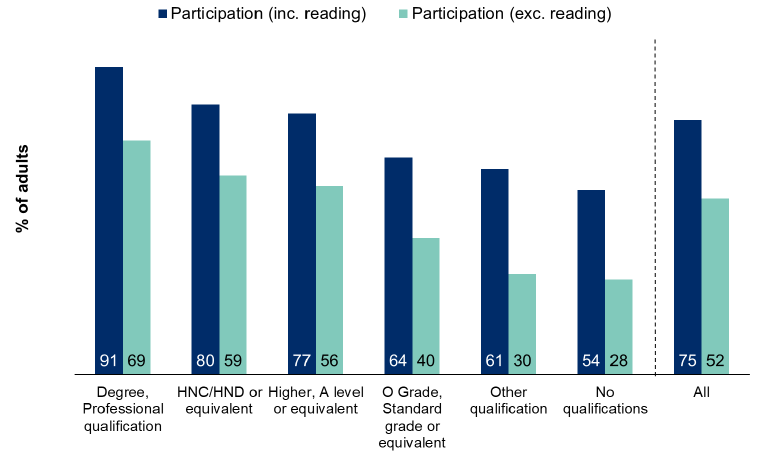
As with the overall figure, participation in individual cultural activities was consistently higher for those with a degree or professional qualification (Table 4.4 – see below). Similarly to attendance patterns, those with a degree or professional qualification were more likely than those with no qualifications to participate in all individual cultural activities listed in the question. In the last 12 months, 81 per cent of those with a degree or professional qualification were more likely to read books for pleasure compared with 42 per cent of those with no qualifications, and to view performances online (34 per cent compared with six per cent).
| Adults | Degree, Professional qualification | HNC/HND or equivalent | Higher, A level or equivalent | O Grade, Standard grade or equivalent | Other qualification | No qualifications | Qualifications not known | All |
|---|---|---|---|---|---|---|---|---|
| Read | 81 | 63 | 61 | 49 | 51 | 42 | 36 | 62 |
| Dance | 18 | 12 | 13 | 8 | 6 | 4 | 3 | 12 |
| Play Instrument | 17 | 12 | 12 | 6 | 2 | 3 | 6 | 11 |
| Taken Part In Play | 2 | 1 | 2 | 0 | 0 | 0 | 1 | 1 |
| Singing Group/Choir | 6 | 3 | 4 | 2 | 2 | 1 | - | 4 |
| Art Sculpture | 16 | 14 | 11 | 8 | 4 | 4 | 6 | 11 |
| Photography | 12 | 9 | 8 | 4 | 1 | 2 | - | 7 |
| FilmMaking | 4 | 3 | 3 | 1 | 1 | 0 | - | 2 |
| Computer Artwork Animation | 11 | 9 | 7 | 3 | 1 | 1 | 1 | 7 |
| Crafts | 21 | 17 | 14 | 12 | 16 | 12 | 9 | 16 |
| Creative Writing | 7 | 5 | 6 | 3 | 1 | 0 | 0 | 5 |
| Viewed Performances Online | 34 | 27 | 26 | 16 | 7 | 6 | 8 | 23 |
| Viewed Cultural Content Online | 19 | 12 | 10 | 5 | 2 | 1 | 4 | 10 |
| Shared Art Creative Content Online | 8 | 6 | 6 | 2 | 0 | 0 | - | 5 |
| Other Cultural | 3 | 3 | 2 | 1 | 1 | 2 | 4 | 2 |
| None | 9 | 20 | 23 | 36 | 39 | 46 | 51 | 25 |
| Participation (exc. reading) | 69 | 59 | 56 | 40 | 30 | 28 | 29 | 52 |
| Participation (inc. reading) | 91 | 80 | 77 | 64 | 61 | 54 | 49 | 75 |
| Base (minimum) | 2,960 | 1,130 | 1,460 | 1,710 | 640 | 1,810 | 70 | 9,780 |
Columns add to more than 100 per cent since multiple responses allowed.
4.4 Participation by Scottish Index of Multiple Deprivation
2019 data show that participation in cultural activity declined as deprivation, as measured by the Scottish Index of Multiple Deprivation (SIMD, 2020), increased. There was a large difference (22 percentage points) in cultural participation between those living in the 20 per cent most deprived and the 20 per cent least deprived areas. Sixty-two per cent of adults in the 20 per cent most deprived areas had participated in cultural activities in 2019, compared with 85 per cent of adults in the 20 per cent least deprived areas (Figure 4.5). This is consistent with the differences observed for cultural attendance.
When reading is excluded, the pattern was similar with 41 per cent of those in the most deprived areas and 60 per cent of those in the least deprived areas of Scotland having participated in a cultural activity.
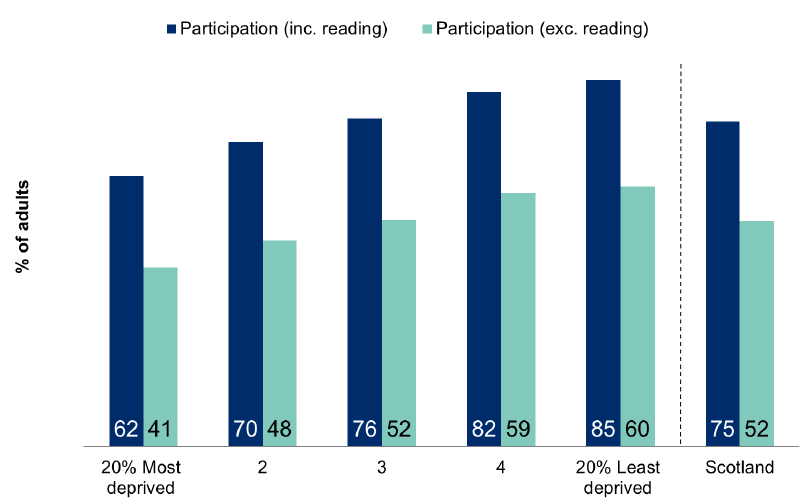
As with the overall figure, participation in individual cultural activities was consistently higher for adults living in the least deprived areas compared to those in the most deprived areas (Table 4.5). However, unlike with attendance where those living in the 20 per cent least deprived areas were more likely to attend or visit all individual cultural events or places compared to those living in the 20 per cent most deprived areas, for participation the two groups were as likely to partake in certain individual activities (e.g. art or sculpture and take part in a play). The most marked differences between those living in the 20 per cent least deprived areas and those living in the 20 per cent most deprived areas were in terms of reading a book for pleasure (74 per cent and 49 per cent respectively) and viewing performances online (27 per cent and 16 per cent respectively).
| Adults | 20% Most deprived | 2 | 3 | 4 | 20% Least deprived | Scotland |
|---|---|---|---|---|---|---|
| Read | 49 | 55 | 63 | 69 | 74 | 62 |
| Dance | 8 | 10 | 11 | 13 | 16 | 12 |
| Play Instrument | 8 | 9 | 10 | 13 | 14 | 11 |
| Taken Part In Play | 1 | 1 | 1 | 1 | 1 | 1 |
| Singing Group/Choir | 2 | 3 | 3 | 5 | 5 | 4 |
| Art Sculpture | 10 | 11 | 10 | 13 | 11 | 11 |
| Photography | 5 | 7 | 9 | 8 | 8 | 7 |
| FilmMaking | 2 | 2 | 2 | 2 | 3 | 2 |
| Computer Artwork Animation | 6 | 6 | 7 | 7 | 9 | 7 |
| Crafts | 11 | 16 | 17 | 19 | 17 | 16 |
| Creative Writing | 4 | 3 | 5 | 5 | 5 | 5 |
| Viewed Performances Online | 16 | 21 | 23 | 26 | 27 | 23 |
| Viewed Cultural Content Online | 7 | 8 | 12 | 12 | 13 | 10 |
| Shared Art Creative Content Online | 5 | 5 | 5 | 4 | 4 | 5 |
| Other Cultural | 2 | 2 | 2 | 3 | 3 | 2 |
| None | 38 | 30 | 24 | 18 | 15 | 25 |
| Participation (exc. reading) | 41 | 48 | 52 | 59 | 60 | 52 |
| Participation (inc. reading) | 62 | 70 | 76 | 82 | 85 | 75 |
| Base (minimum) | 1,830 | 1,980 | 2,150 | 2,020 | 1,800 | 9,780 |
Columns add to more than 100 per cent since multiple responses allowed.
4.5 Participation by Net Annual Household Income
2019 data show that cultural participation was highest for those with the highest net annual household income. Similarly to attendance at cultural events or places, there was a general pattern of participation increasing with level of income, though the differences are less marked than with attendance. Eighty per cent of those with a net annual household income of over £30,000 participated in cultural activities (Figure 4.6). Participation was lowest for those with a net annual household income of between £0 and £10,000, and £10,001 and £20,000 (70 per cent for both groups). The pattern holds when reading is excluded (58 per cent compared to 43 and 44 per cent respectively).
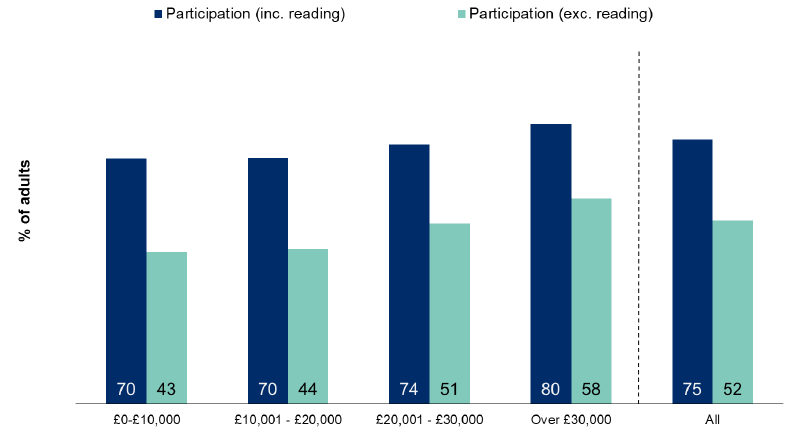
As with the overall figure, participation in individual cultural activities was higher for most activities for adults with a net annual household income of over £30,000 (Table 4.6). Those with a net annual household income of between £0 and £10,000, and those with a net annual household income of over £30,000, were as likely to partake in certain individual activities (e.g. creative writing and crafts). The most marked differences can be seen between those with the highest net annual household income and those with a net annual household income of between £10,001 and £20,000 in viewing performances online (28 per cent compared to 16 per cent respectively) and reading for pleasure (65 per cent compared to 57 per cent respectively).
| Adults | £0-£10,000 | £10,001 - £20,000 | £20,001 - £30,000 | Over £30,000 | All |
|---|---|---|---|---|---|
| Read | 62 | 57 | 61 | 65 | 62 |
| Dance | 8 | 8 | 12 | 15 | 12 |
| Play Instrument | 9 | 8 | 9 | 13 | 11 |
| Taken Part In Play | 1 | 1 | 1 | 1 | 1 |
| Singing Group/Choir | 3 | 3 | 3 | 5 | 4 |
| Art Sculpture | 10 | 10 | 11 | 12 | 11 |
| Photography | 6 | 6 | 6 | 9 | 8 |
| FilmMaking | 2 | 1 | 2 | 3 | 2 |
| Computer Artwork Animation | 5 | 5 | 6 | 9 | 7 |
| Crafts | 16 | 16 | 18 | 15 | 16 |
| Creative Writing | 5 | 4 | 5 | 5 | 4 |
| Viewed Performances Online | 18 | 16 | 21 | 28 | 23 |
| Viewed Cultural Content Online | 9 | 7 | 10 | 13 | 11 |
| Shared Art Creative Content Online | 4 | 4 | 5 | 6 | 5 |
| Other Cultural | 2 | 2 | 2 | 3 | 2 |
| None | 30 | 30 | 26 | 20 | 25 |
| Participation (exc. reading) | 43 | 44 | 51 | 58 | 52 |
| Participation (inc. reading) | 70 | 70 | 74 | 80 | 75 |
| Base (minimum) | 900 | 2,880 | 2,100 | 3,500 | 9,380 |
Columns add to more than 100 per cent since multiple responses allowed.
4.6 Participation by Long-Term Physical or Mental Health Condition
2019 data show that cultural participation was lowest amongst those with a condition that caused long-term major reduced daily capacity (61 per cent) and highest amongst those with a condition that did not cause reduced daily capacity (80 per cent) (Figure 4.7) and those with no long-term physical or mental health condition (77 per cent). Those with minor reduced daily capacity the participation rate was 76 per cent.
When reading is excluded, participation for those with a condition that caused major reduced daily capacity was 37 per cent and, for those with no long-term physical or mental health condition, it was 55 per cent. For those with a condition that caused minor reduced daily capacity, the participation rate was 51 per cent and for those with a condition that caused no reduced daily capacity, the participation rate was 54 per cent.
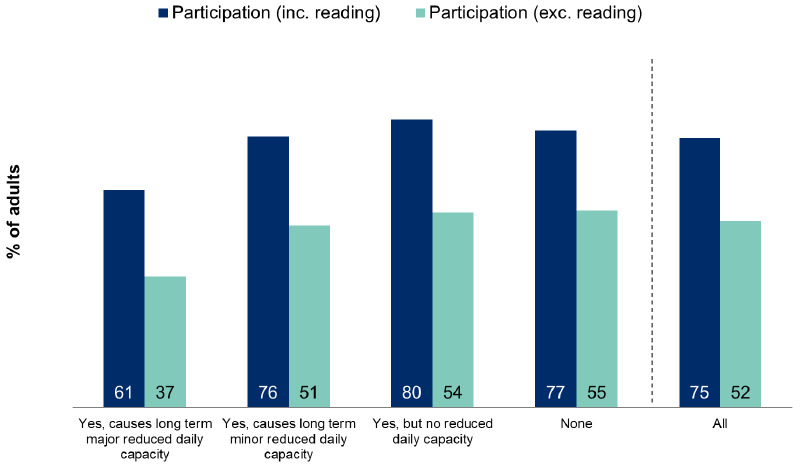
The picture in terms of participation varies across the different sub-groups and the different activities. Participation in individual cultural activities was higher for most activities for adults with no long-term physical or mental health condition and those with a condition that did not cause reduced daily capacity compared with those with a condition that caused major reduced daily capacity (Table 4.7).
The most marked sub-group difference can be seen for reading books for pleasure. Forty-nine per cent of those with a condition that caused long-term major reduced daily capacity had read in the last 12 months compared with 68 per cent of those with a condition that did not cause reduced daily capacity. 64 per cent of those with no long-term physical or mental health condition and 62 per cent of those with a condition that caused long-term minor reduced daily capacity had read in the last 12 months.
Those with a condition that caused long-term minor reduced daily capacity were more likely to participate in crafts than those with no long-term physical or mental health condition (20 per cent and 15 per cent respectively).
| Adults | Yes, causes long term major reduced daily capacity | Yes, causes long term minor reduced daily capacity | Yes, but no reduced daily capacity | None | All |
|---|---|---|---|---|---|
| Read | 49 | 62 | 68 | 64 | 62 |
| Dance | 5 | 10 | 11 | 13 | 12 |
| Play Instrument | 6 | 8 | 10 | 12 | 11 |
| Taken Part In Play | 0 | 1 | 1 | 1 | 1 |
| Singing Group/Choir | 2 | 4 | 4 | 4 | 4 |
| Art Sculpture | 9 | 10 | 10 | 11 | 11 |
| Photography | 5 | 6 | 9 | 8 | 7 |
| FilmMaking | 1 | 2 | 3 | 3 | 2 |
| Computer Artwork Animation | 3 | 6 | 7 | 8 | 7 |
| Crafts | 14 | 20 | 19 | 15 | 16 |
| Creative Writing | 4 | 4 | 5 | 5 | 5 |
| Viewed Performances Online | 12 | 21 | 21 | 25 | 23 |
| Viewed Cultural Content Online | 7 | 10 | 10 | 11 | 10 |
| Shared Art Creative Content Online | 3 | 5 | 4 | 5 | 5 |
| Other Cultural | 2 | 3 | 3 | 2 | 2 |
| None | 39 | 24 | 20 | 23 | 25 |
| Participation (exc. reading) | 37 | 51 | 54 | 55 | 52 |
| Participation (inc. reading) | 61 | 76 | 80 | 77 | 75 |
| Base | 1,560 | 1,290 | 610 | 6,270 | 9,780 |
Columns add to more than 100 per cent since multiple responses allowed.
4.7 Frequency of Participation in Cultural Activities
2019 data show that those who read a book for pleasure had participated in the cultural activity the most frequently (Table 4.8). Of those who read for pleasure, 75 per cent had done so at least once a week, and a further 13 per cent had read less often than once a week, but at least once a month. 56 per cent of those who had played a musical instrument, had done so at least once a week. Sixty-nine per cent of those who had taken part in a play had done so less often than once a month but within the last 12 months.
| Adult | At least once a week | Less often than once a week / at least once a month | Less often than once a month but within the last 12 months | Don't know | Total | Base |
|---|---|---|---|---|---|---|
| Read | 75 | 13 | 12 | 0 | 100 | 6,250 |
| Dance | 42 | 24 | 34 | 0 | 100 | 1,100 |
| Play Instrument | 56 | 22 | 21 | 0 | 100 | 960 |
| Taken Part In Play | 14 | 17 | 69 | - | 100 | 100 |
| Singing Group/Choir | 56 | 20 | 24 | - | 100 | 390 |
| Art Sculpture | 36 | 32 | 32 | 0 | 100 | 990 |
| Photography | 36 | 35 | 28 | 1 | 100 | 690 |
| Film Making | 21 | 26 | 53 | - | 100 | 190 |
| Computer Artwork Animation | 34 | 32 | 33 | 2 | 100 | 580 |
| Crafts | 47 | 26 | 26 | 1 | 100 | 1,780 |
| Creative Writing | 35 | 28 | 37 | 0 | 100 | 400 |
| Viewed Performances Online | 45 | 28 | 26 | 1 | 100 | 1,990 |
| Viewed Cultural Content Online | 36 | 30 | 34 | 1 | 100 | 1,000 |
| Shared Art Creative Content Online | 31 | 26 | 41 | 2 | 100 | 410 |
| Other Cultural | 43 | 18 | 36 | 2 | 100 | 230 |
Columns add to more than 100 per cent since multiple responses allowed.
Respondents had participated in cultural activities more frequently than they had attended or visited cultural events or places of culture. Nineteen per cent had attended a library at least once a week (Table 3.8) but, apart from this, attendance at cultural events at least once a week was low. Participation in cultural activities at least once a week ranged from 14 per cent to 75 per cent.
4.8 Aspirations of Participation in Cultural Activities
A new biennial question asking those who reported participating in cultural activities in the last 12 months, which activities they would like to do more often or do that they haven’t done before, was included in the 2019 Scottish Household Survey (Figure 4.8). Although the majority responded ‘none’ (61 per cent), 15 per cent wanted to read a book for pleasure more often or participate in this activity. This was followed by crafts and playing an instrument (eight per cent for both).
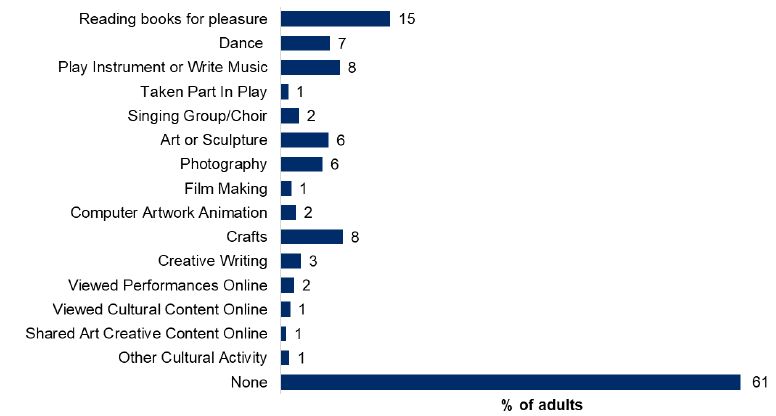
A further new biennial question introduced to the 2019 SHS asked those who did not report participating in any cultural activities in the last 12 months, which activities they would like to do (Figure 4.9). The vast majority (84 per cent) responded ‘none’. Six per cent responded reading a book for pleasure, followed by dancing and crafts (three per cent for both).
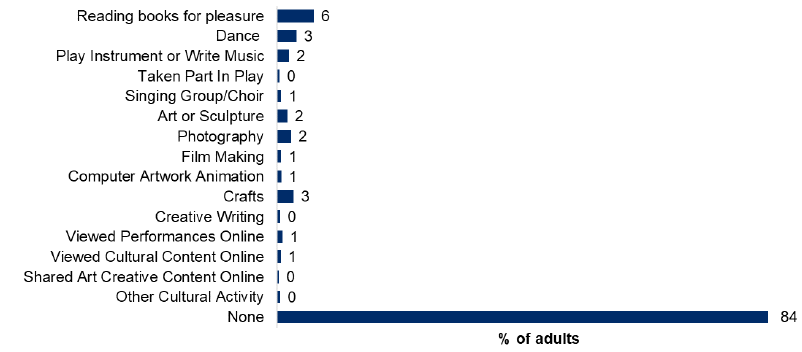
4.9 Limiting or Preventing Factors Affecting Participation
A new biennial question in the 2019 Scottish Household Survey asked what, if anything, limits or prevents people from participating in cultural activities. The question was asked of all adults, both those who had participated in cultural activities in the last 12 months and those who had not. Around one in five (19 per cent) reported this was due to lack of time, while seven per cent said they just had not got round to it (Figure 4.10).
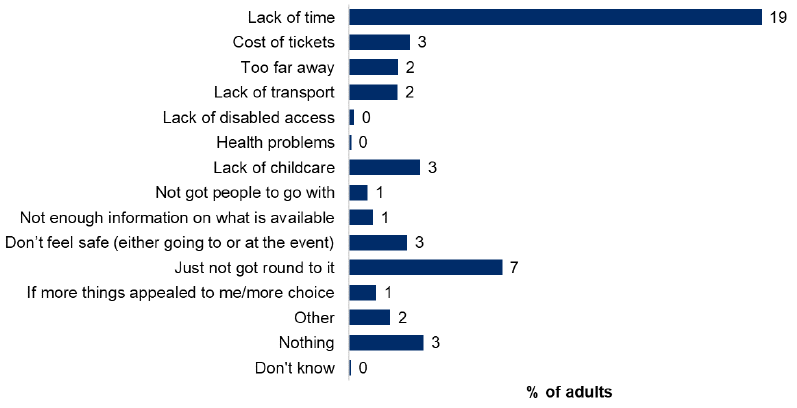
Contact
Email: socialresearch@gov.scot
There is a problem
Thanks for your feedback